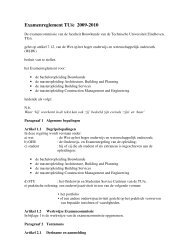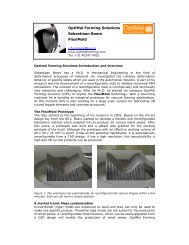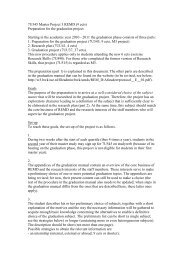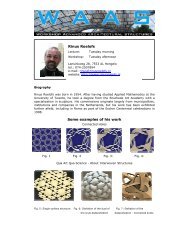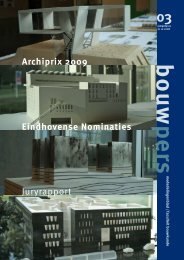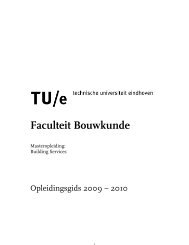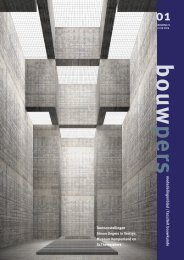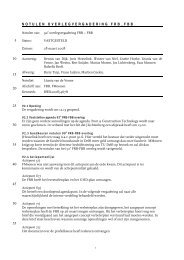Create successful ePaper yourself
Turn your PDF publications into a flip-book with our unique Google optimized e-Paper software.
<strong>Adaptive</strong> Thermal <strong>Comfort</strong>:<br />
Past, Present and Future<br />
Richard de Dear<br />
Faculty of Architecture, Design and Planning<br />
University of Sydney, Australia
Acknowledgements<br />
I wish to acknowledge the inspiration and direct<br />
contributions made to my thinking on this topic<br />
over the last 30 years by:<br />
- Andris Auliciems<br />
- Per Ole Fanger<br />
- Michael Humphreys
Past<br />
• Charles Webb (Building Research Establishment UK) is regarded by<br />
Michael Humphreys as the originator of the adaptive comfort concept<br />
• Conducted longitudinal field studies in Singapore, Baghdad, north India<br />
and north London during the 1960s<br />
• From these diverse field studies Webb noticed that his sample of<br />
building occupants seemed to be most comfortable in the mean<br />
temperatures to which they were exposed. He suggested that they had<br />
adapted to their indoor climates
Humphreys and Nicol (1970)<br />
Mean monthly comfort votes and indoor temperature – Singapore, England, India, Baghdad
Nicol and Humphreys 1972<br />
Trying to make sense of this counter-intuitive finding Nicol<br />
and Humphreys proposed the idea that building occupants<br />
and their indoor climate were two parts of an integrated,<br />
self-regulating (feedback) system. They postulated the<br />
adaptive principle: If a change occurs that produces<br />
discomfort, people will tend to act to restore their comfort<br />
- physiological adaptation (aka acclimatization)<br />
- behavioural adaptation (personal & environmental)<br />
In other words the target of the “controlled variable” in this<br />
homeostatic system was thermal comfort
The <strong>Adaptive</strong> Principle:<br />
If a change occurs that produces discomfort,<br />
people will tend to act to restore their comfort<br />
physiological<br />
thermoregulation<br />
Thermal dis/comfort<br />
thermoreception<br />
& integration<br />
behavioural<br />
thermoregulation<br />
body heat-balance<br />
thermal environment
Humphreys’ Meta-Analysis<br />
To test the adaptive feedback concept of thermal comfort<br />
Humphreys compiled a database of all the field studies that<br />
had been published by the mid-1970s. For each he<br />
extracted:<br />
- temperature at which comfort was observed (neutrality)<br />
- the mean indoor temperature recorded for each study<br />
Field data came from all over the world (from Russia, USA,<br />
UK, Australia, western Europe, Scandinavia, India, Africa etc
Humphreys’ Meta-Analysis (1975)
Auliciems<br />
Upon hearing Humphreys’ findings at a seminar in the late<br />
1970s, Andris Auliciems, a self-confessed latter-day climatic<br />
determinist (!), opined that the driver for adaptation was not<br />
only indoor temperature, but also outdoor climate:<br />
- physiological adaptation (acclimatisation)<br />
- behavioural (adjustment)<br />
- psychological (expectation)<br />
- cultural (technology)
Humphreys’ 2 nd Meta-Analysis (1978)
Auliciems’ <strong>Adaptive</strong> Model (1981)
De Dear<br />
A young (!) PhD student under Andris Auliciems at the<br />
University of Queensland in 1981 looked at this topic and<br />
noticed two things:<br />
- Humphreys’, Nicol’s and Auliciems’ seminal ideas had not<br />
progressed as far as he thought they should’ve<br />
- Fanger’s ingenious heat-balance approach to comfort had<br />
displaced adaptive concept and its supporting evidence
De Dear<br />
For his PhD project de Dear pitted these two competing<br />
hypotheses against each other (adaptive versus heatbalance)<br />
in a series of field experiments in Australia:<br />
- Tropical Darwin, sub-tropical Brisbane, temperate Melbourne<br />
- naturally ventilated and centrally air-conditioned office buildings<br />
- collected all six of the parameters in Fanger’s PMV model<br />
- compared actual and predicted comfort<br />
Systematic discrepancies were found, particularly in the<br />
warmer climate zones, that couldn’t be explained by the<br />
classic six comfort parameters in Fanger’s heat-balance<br />
model (PMV).
De Dear 1994
The ASHRAE <strong>Comfort</strong> Database<br />
• In the early 1990s the American Society of Heating,<br />
Refrigerating and Air-Conditioning Engineers (ASHRAE) got<br />
interested in field studies of thermal comfort<br />
• ASHRAE commissioned thermal comfort field experiments…<br />
– objective measurements of indoor climate with laboratory precision<br />
– Subjective assessments of those conditions using standardised questionnaires<br />
• The result of those studies (and many others) over many<br />
years is a consolidated database on the web, freely<br />
accessible to anyone who is interested<br />
(look for Richard de Dear here http://sydney.edu.au)
Brager and Arens<br />
Brought laboratory precision into the field to rebut frequent criticisms of field results
The ASHRAE <strong>Adaptive</strong> <strong>Comfort</strong> Project<br />
The ASHRAE <strong>Adaptive</strong> <strong>Comfort</strong> Project<br />
(de Dear and Brager 1998 ASHRAE Transactions)<br />
• circa 21,000 observations (indoor climate & comfort surveys)<br />
- 160 buildings<br />
- 4 continents<br />
- range of climate zones<br />
• Simultaneous and<br />
contiguous observations :<br />
- objective indoor climate<br />
- subjective comfort<br />
•<br />
•<br />
•<br />
•<br />
• • •<br />
•<br />
• ••<br />
•<br />
•<br />
•<br />
•<br />
•<br />
• •<br />
•<br />
•<br />
•
<strong>Adaptive</strong> <strong>Comfort</strong> – The Present<br />
Driven largely by concerns about global climate<br />
change, but also the failure of tightly controlled<br />
and uniform indoor climates to deliver universal<br />
thermal comfort to building occupants, the focus<br />
in the last decade has been on developing<br />
adaptive comfort standards and guidelines:<br />
• ASHRAE Standard 55-2004<br />
“Thermal environmental conditions for human occupancy”<br />
• CEN Standard EN15252-2007<br />
“Indoor environmental input parameters for design and assessment<br />
of energy performance of buildings”
ASHRAE RP-884 database analysis<br />
Centrally-controlled HVAC buildings<br />
indoor comfort temp’ ( o C)<br />
27<br />
26<br />
25<br />
24<br />
23<br />
22<br />
21<br />
20<br />
-5 0 5 10 15 20 25 30 35<br />
Monthly outdoor temperature ( o C)<br />
indoor comfort temp’ ( o C)<br />
Naturally ventilated buildings<br />
27<br />
26<br />
25<br />
24<br />
23<br />
22<br />
21<br />
20<br />
-5 0 5 10 15 20 25 30 35<br />
Monthly outdoor temperature ( o C)<br />
Predicted: static comfort model (PMV)<br />
Observed: Field-based adaptive model
“static”<br />
ASHRAE 55-2004 : <strong>Comfort</strong> Standard<br />
HVAC standard adaptive NV standard<br />
HUMIDITY MIXING RATIO (g/kg)<br />
15<br />
10<br />
5<br />
20 o C Wet Bulb<br />
18 o C Wet Bulb<br />
100% rh<br />
Winter<br />
70% rh<br />
60% rh<br />
50% rh<br />
Summer<br />
30% rh<br />
20 ET*<br />
26 ET*<br />
0<br />
15 20 25 30<br />
OPERATIVE TEMPERATURE ( o C)
Differences Between CEN and ASHRAE<br />
<strong>Adaptive</strong> <strong>Comfort</strong> Standards
Similarities Between CEN and ASHRAE<br />
<strong>Adaptive</strong> <strong>Comfort</strong> Standards
Future: Applying the <strong>Adaptive</strong> Standards<br />
Intergovernmental Panel on Climate Change<br />
(IPCC) greenhouse mitigation potential by 2030
Application of the ASHRAE 55-2004 <strong>Adaptive</strong><br />
<strong>Comfort</strong> Standard to San Francisco’s s climate<br />
From McConahey, E., P. Haves and T. Christ (2002)
The San Francisco Federal Building, 2008<br />
(source: (source: www.structurae.de www.structurae.de photographer: photographer: Nicolas Nicolas Janberg)<br />
Janberg)
Future: Applying the <strong>Adaptive</strong> Standards<br />
Design tools : Climate Consultant V.5 (coming soon)
Future: Applying the <strong>Adaptive</strong> Standards<br />
Design tools : Climate Consultant V.5 (coming soon)
Future: Applying the <strong>Adaptive</strong> Standards<br />
Design tools : Climate Consultant V.5 (coming soon)
Future: Applying the <strong>Adaptive</strong> Standards<br />
Design tools : Climate Consultant V.5 (coming soon)
Conclusions<br />
• Many more people have played a role in progressing the adaptive<br />
comfort concept to what we recognise today.<br />
• Much of the “action” appears in the East and South Asian regions. For<br />
example, China continues to add 1 billion m 2 floor-area of new<br />
construction per annum. Much (if not most) of the new adaptive comfort<br />
research is happening in China nowadays and we will start seeing more<br />
an more of it being published in English research journals.<br />
• In developed economies the key challenge lies in retrofitting adaptive<br />
comfort into existing buildings. The term “adaptive HVAC” has already<br />
been coined. But this implies “weaning” occupants off tightly regulated<br />
(static) indoor climates.<br />
• Perhaps the final frontier for adaptive thermal comfort researchers will be<br />
the “engineering of building occupants’ attitudes towards and<br />
expectations of indoor climates. Green buildings need green occupants!
Thank you for your attention



